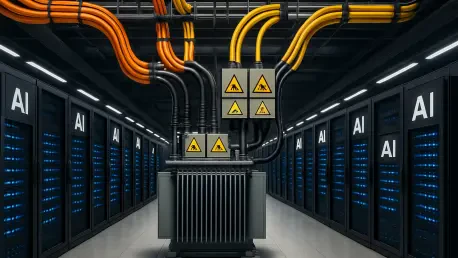What happens when the engines of the digital age demand energy at a scale that dwarfs entire facilities of just a decade ago? Data centers, the unsung heroes of cloud computing and artificial intelligence, are on a collision course with an unprecedented challenge: AI-driven racks projected to consume a staggering 1MW of power each by 2030. This isn’t merely a technical glitch; it’s a seismic shift that could redefine how technology powers the world. The race is on to keep up with AI’s insatiable hunger for energy, and the stakes couldn’t be higher.
The importance of this issue extends far beyond server rooms and tech labs. As AI becomes the backbone of everything from healthcare diagnostics to financial forecasting, the infrastructure supporting it must evolve at breakneck speed. Failure to address this looming energy crisis risks disrupting critical services and stalling global innovation. With power demands escalating 20 to 30 times higher than traditional setups, data centers are at a pivotal moment—adapt or falter. This story uncovers the challenges, innovations, and strategies shaping the future of digital infrastructure.
A Looming Energy Crisis in Tech’s Core
Data centers have long operated as the silent workhorses of the internet, but AI is transforming them into power-hungry behemoths. A typical rack today might draw between 30 and 50kW, a manageable load for most facilities. However, projections for AI workloads suggest a leap to 1MW per rack within the next five years, a figure once associated with entire data halls. This exponential jump signals a crisis that could strain energy grids worldwide if left unchecked.
The implications ripple across industries reliant on digital systems. Cloud services, streaming platforms, and enterprise solutions all hinge on the stability of these centers. As AI models grow more complex, requiring immense computational muscle, the energy needed to train and run them skyrockets. Governments and corporations are beginning to take notice, recognizing that this isn’t just a tech problem—it’s a global resource challenge demanding urgent attention.
Beyond raw numbers, the environmental footprint looms large. Data centers already account for a significant chunk of global electricity use, and a surge to 1MW per rack could amplify carbon emissions unless sustainable solutions emerge. The pressure is mounting to balance technological progress with ecological responsibility, setting the stage for a critical battle in the heart of tech.
Why AI’s Power Hunger Sparks Global Alarm
The driving force behind this energy surge is AI’s relentless need for computational power. Unlike traditional servers handling basic tasks, AI systems—think machine learning algorithms and neural networks—perform trillions of calculations per second. This intensity translates to power consumption that can dwarf conventional setups by a factor of 30, pushing data centers into uncharted territory.
This isn’t merely a niche concern for tech giants; it’s a systemic issue affecting global economies. From small businesses relying on cloud storage to nations building smart cities, dependence on AI is ubiquitous. If data centers can’t sustain these workloads, critical operations could grind to a halt, disrupting everything from online transactions to emergency response systems. The ripple effects would be felt by billions.
Sustainability adds another layer of urgency. With energy demands soaring, the strain on non-renewable resources intensifies, prompting calls for greener practices. Policymakers and industry leaders are grappling with how to support AI’s growth without exacerbating climate challenges. The conversation has shifted from optional innovation to necessary survival, as the world watches how this unfolds.
Decoding the 1MW Rack Dilemma
Achieving stability at 1MW per rack requires rethinking every aspect of data center design. Power delivery stands as a primary obstacle, with current systems ill-equipped for such loads. High-voltage DC setups, like +/-400V configurations, are gaining traction to minimize energy loss and reduce the bulk of cabling, offering a more efficient path forward for sprawling facilities.
Cooling, too, has evolved from a secondary concern to a make-or-break factor. As compute densities climb, traditional air-based methods fall short, unable to dissipate the heat generated by AI hardware. Liquid cooling, supported by centralized coolant distribution units and rack manifolds, is emerging as a frontrunner, capable of handling the thermal load more effectively. This shift demands not just new technology but a reimagining of facility layouts.
Rack design itself is under the microscope. Capacity and physical structure must align with these extreme power and cooling needs, influencing everything from server placement to airflow dynamics. By 2030, a rack’s architecture could be as crucial as the processors it holds. These intertwined challenges—power, cooling, and design—signal a holistic overhaul of data center priorities to keep pace with AI’s demands.
Industry Insights and Breakthrough Solutions
Voices from the field highlight the urgency of these shifts, with cooling often dominating discussions. Ted Pulfer, a director at a leading data center solutions provider, notes that thermal management is no longer a side topic but the central focus of industry dialogue. His perspective reflects a broader consensus: without innovative cooling, AI’s potential could be throttled by overheating hardware.
Cutting-edge experiments are lighting the way. Microsoft’s work with microfluidics, for instance, channels coolant through tiny grooves etched into chips, achieving heat removal up to three times more effective than standard methods. This approach also cuts GPU temperature spikes by 65%, using AI to target specific hotspots. Such advancements demonstrate how technology can address its own limitations with precision.
Collaboration is proving just as vital as invention. Manufacturers, engineers, and operators are pooling expertise to test solutions in real-world settings, from lab trials to full-scale deployments. This collective push underscores a shared recognition: the path to 1MW racks isn’t a solo journey but a joint mission to redefine what data centers can achieve in an AI-driven era.
Charting the Path Forward for Data Centers
For data centers—whether sprawling hyperscalers or nimble smaller players—adapting to AI’s energy demands is non-negotiable. Scalable power systems, such as high-voltage DC, offer a starting point to curb waste and build capacity for future growth. Implementing these now can prevent costly retrofits as power needs escalate over the next few years.
Investment in advanced cooling is equally critical. Liquid cooling and microfluidics aren’t mere experiments but essential tools for managing high-density AI workloads. Smaller operators, in particular, can gain an edge by moving swiftly to adopt these technologies, sidestepping supply chain delays that often hamper larger competitors. Speed and foresight will define success in this race.
Holistic planning rounds out the strategy. Integrating power, cooling, and rack capacity from the design phase ensures long-term reliability. Data centers must anticipate needs through 2030 and beyond, embedding flexibility into every decision. These steps, grounded in practicality, provide a blueprint for navigating AI’s energy surge while maintaining efficiency and sustainability.
Reflecting on a Pivotal Moment
Looking back, the journey toward managing AI’s colossal power demands revealed a profound shift in data center dynamics. The projection of 1MW per rack by 2030 stood as a daunting benchmark, yet it sparked remarkable ingenuity. Industry leaders and innovators tackled the challenge head-on, forging solutions that redefined technological boundaries.
As the dust settled, the focus turned to actionable progress. Data centers needed to prioritize scalable infrastructure and cutting-edge cooling, ensuring they could support AI without buckling under pressure. Smaller players found opportunities in agility, while larger entities drove systemic change through collaboration. The path ahead demanded sustained investment in sustainable practices to safeguard both technology and the planet.
Ultimately, the response to this energy crisis shaped more than just server rooms—it influenced how society harnessed AI for good. The lessons learned underscored the need for proactive adaptation, urging stakeholders to anticipate future hurdles with the same resolve. This chapter closed with a clear message: innovation, paired with strategic vision, holds the key to powering the digital future.









